Reviews
The 2019 Whitney Biennial Shows America’s Artists Turning Toward Coded Languages in Turbulent Times
There are at least three ways to look at the dominant trend in the 2019 survey.
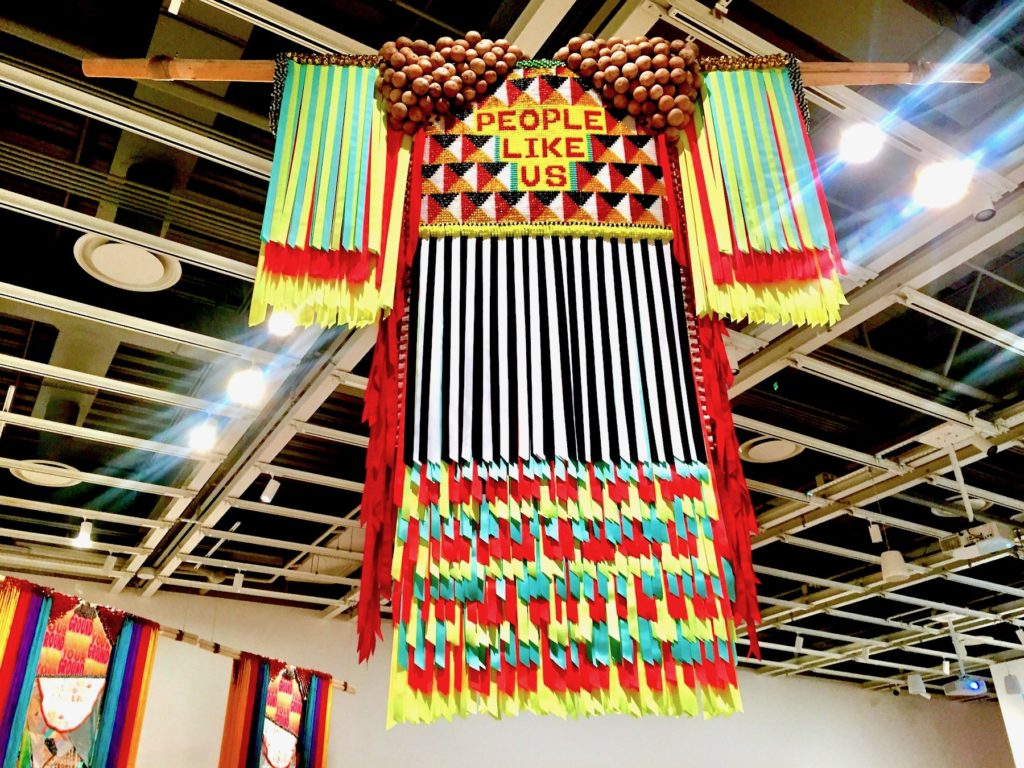
There are at least three ways to look at the dominant trend in the 2019 survey.

Ben Davis

History, identity, craft, and community—these are the themes that curators Rujeko Hockley and Jane Panetta say they discovered in their years-long research for the 2019 Whitney Biennial. But these headings are a bit too broad to offer real clarity about art in the present—and indeed, a retreat from clarity is one of the hallmarks of the show.
Simone Leigh has become a pivotal figure the last few years, currently the subject of a Hugo Boss Prize show at the Guggenheim and a monumental commission inaugurating a new plinth on the High Line. Her human-scaled ceramic sculptures of black female figures are here in the Biennial too, and they well could serve as a kind of role model for a lot of the art on view.
Merging their bodily references with various kinds of architectural forms, Leigh’s sculptures are icons of solidity, stability. There is an implicit claim being made for the value of holding space within the museum for a black feminist subjectivity—but the art isn’t critical in its references, isn’t addressed to power.
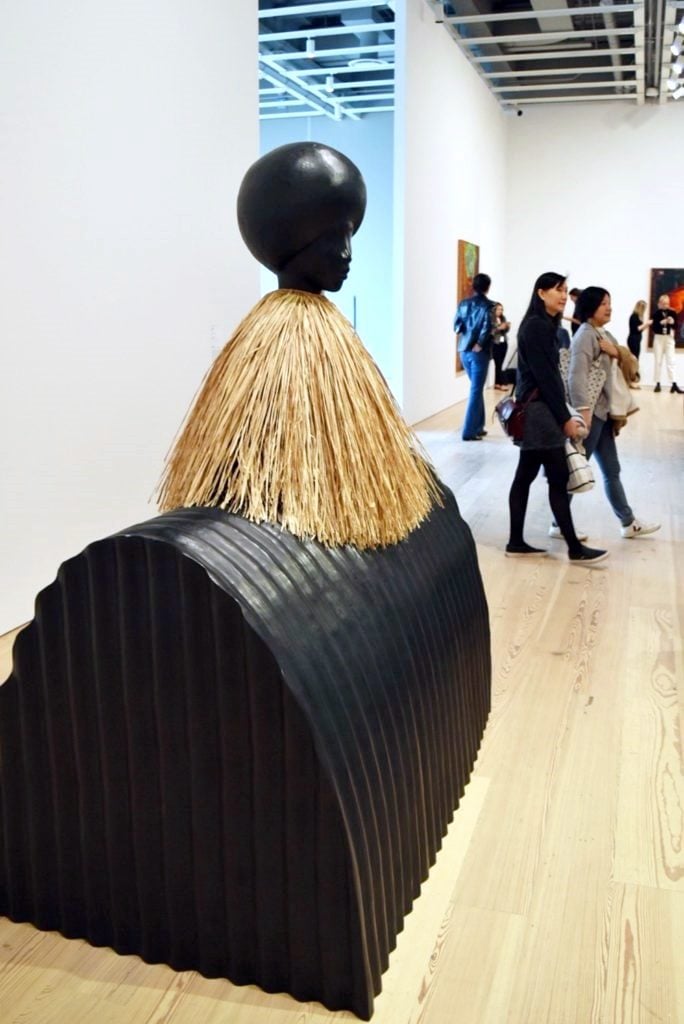
Simone Leigh, Corrugated Lady (2018). Image courtesy Ben Davis.
One signature of Leigh’s sculpture is that, where the eyes should be, there is just a smooth surface. Because the overall tone is so centered and serene, this seems less a gesture of erasure or disfigurement than a way of conveying self-sufficiency. It suggests an emphasis on interior life rather than performing for an audience.
That turn inwards is what I am going to remember from the art of this show.
Hockley writes in her catalogue essay that, while researching the 2019 show, the curators were struck by the fact that, across the country, the work that felt most relevant often involved “making central, and even foregrounding, race, gender, disability, and access.” You feel that throughout the galleries here.
After years of criticism of these survey shows, this is a majority-minority biennial, led particularly by black women. (Indeed, looking for themes, I did a web analysis of the online texts for the show: “black” is the 36th most-used word—about as common as “into,” and more common than the word “biennial.”)
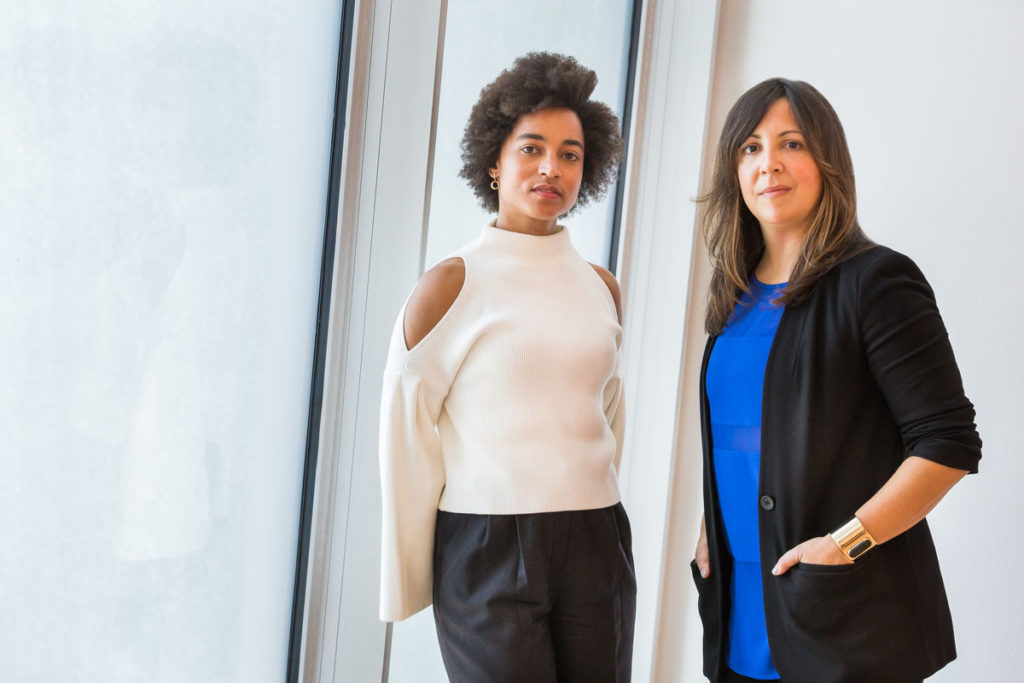
2019 Whitney Biennial curators Rujeko Hockley (left) and Jane Panetta (right). Photograph by Scott Rudd.
Still, the word “foregrounding” seems to have a somewhat mutated meaning here. Compared to the brash declamations of, say, the now-legendary (and now-quarter-century-old) biennial of 1993—sometimes derisively remembered as the “identity politics” biennial—or even the atmosphere of despair and righteousness in this year’s just-opened Venice Biennale, the 2019 Whitney Biennial seems relatively tender and deliberately reserved.
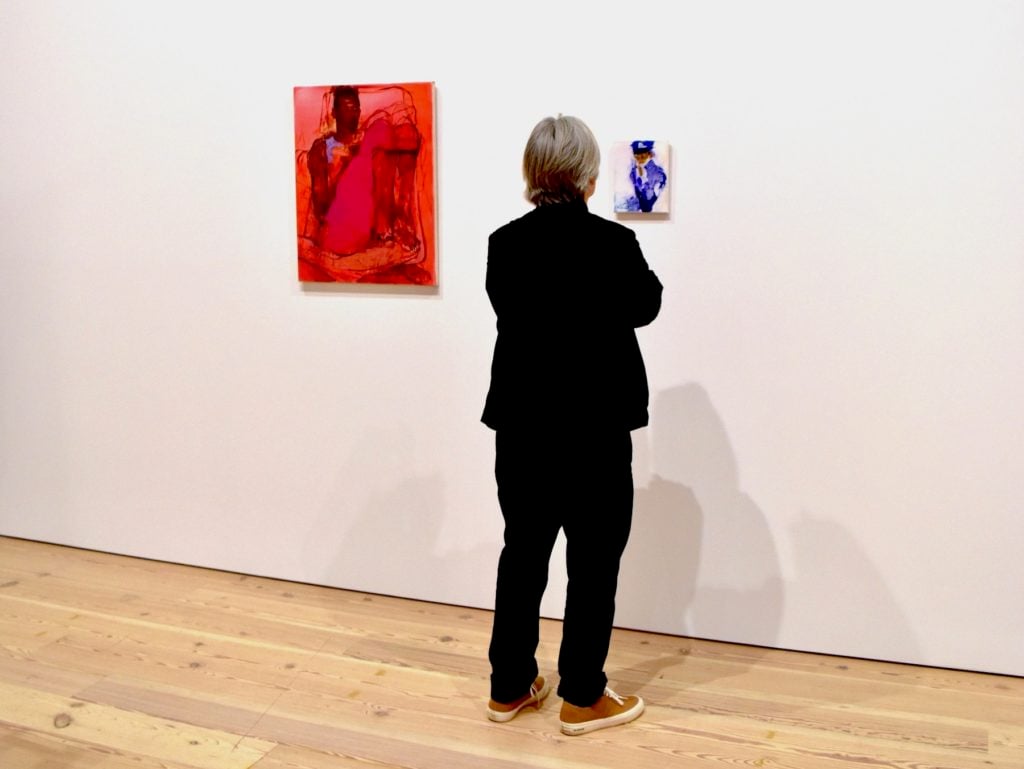
Viewer looking at work by Jennifer Packer. Image courtesy Ben Davis.
This manifests in a rhetoric of deliberate obscuring. For instance, the woozy, colorful paintings of Jennifer Packer render distinct subjects, primarily friends and family of the artist—but they seem to be melting away into indistinction. “By not painting them fully, by not giving over fully to the viewer, that becomes this protective gesture and even a way to keep some of the intimacy to these sitters,” Panetta explains.
A quilted aesthetic recurs elsewhere, with surfaces that are highly patterned, don’t quite unite into a single image, and have the pathos of craft—and that also absorb into themselves materials that hint at layers of loaded meaning if you get in close, without actually stating that meaning.
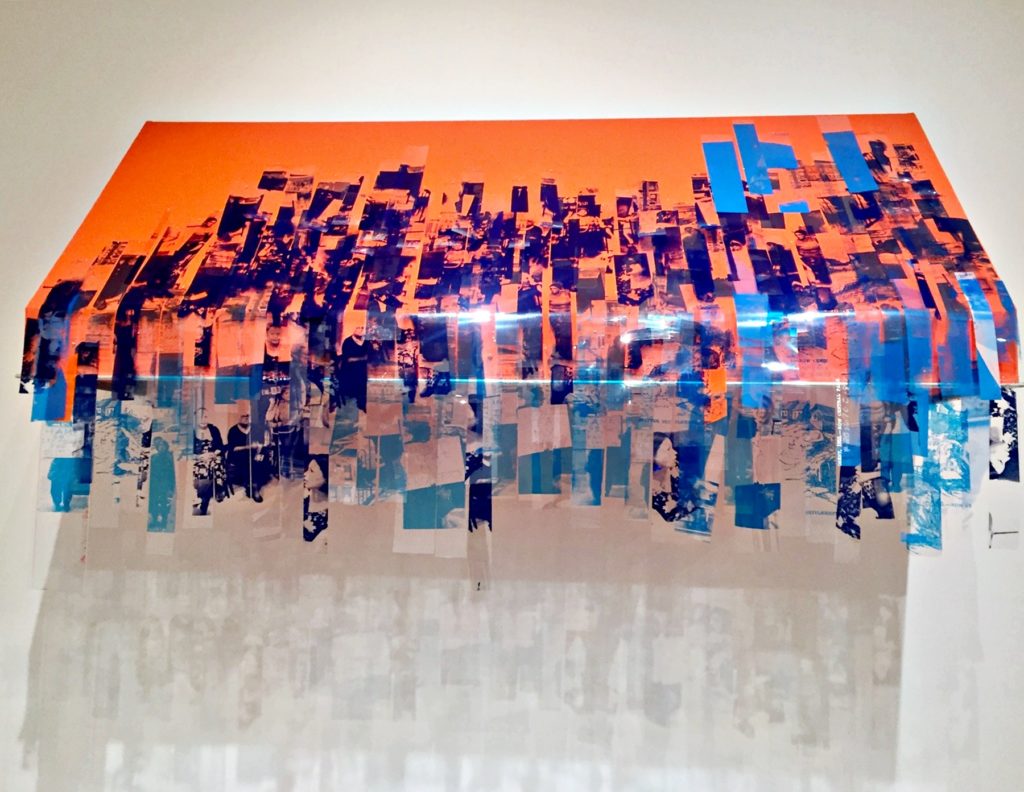
Tomashi Jackson, Third Party Transfer and the Making of Central Park (Seneca Village – Brooklyn 1853-2019) (2019). Image courtesy Ben Davis.
This is true of Tomashi Jackson’s colorful draped compositions, studded with an undergrowth of political buttons and photos relating to contemporary and historical housing struggles in New York.
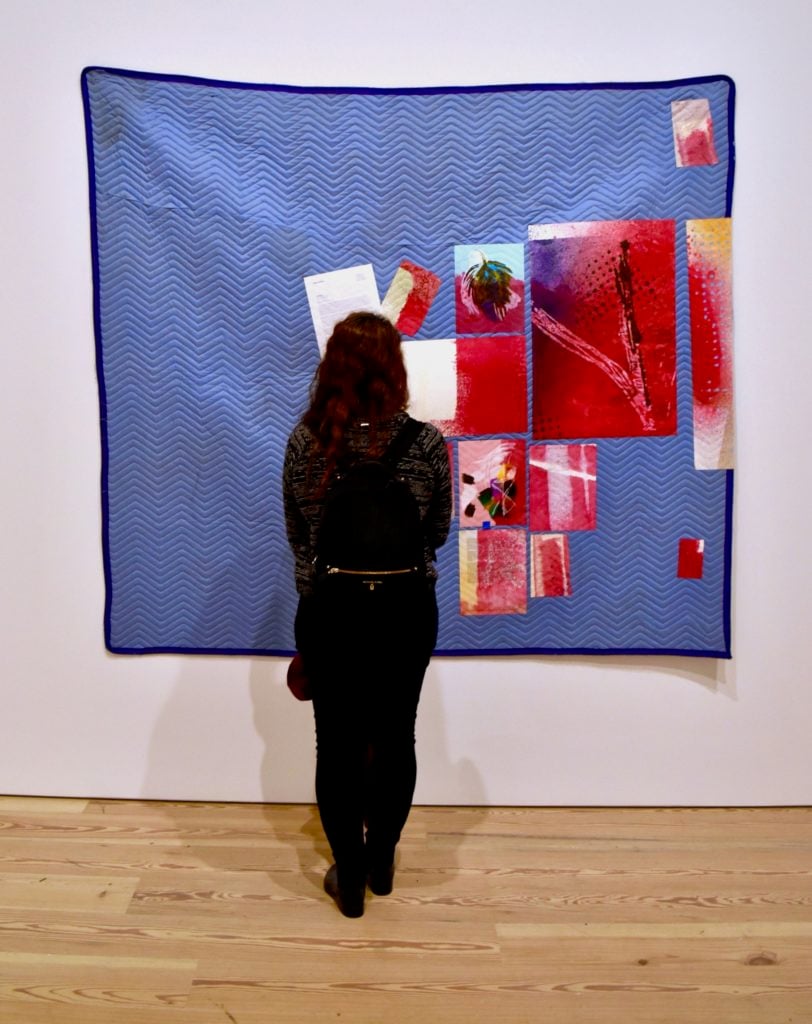
A viewer reads the press release in Eric N. Mack’s (Easter) The Spring/Holy Ground (2018).
This is true of Eric N. Mack’s scrappy fabric work that incorporates moving blankets, as a symbol of nurturing space and shelter, and a press release for a gallery show about one of his artistic heroes (Alvin Baltrop, who focused on gay New York life in the 1970s and ’80s).
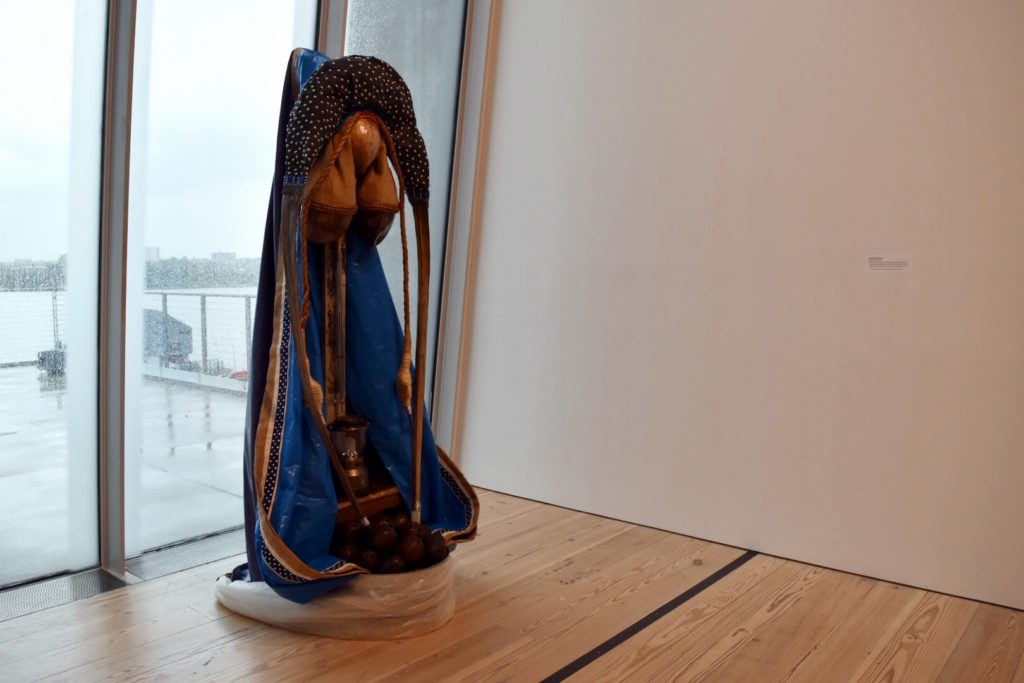
Daniel Lind-Ramos, Maria-Maria (2019). Image courtesy Ben Davis.
In a sculptural register, it’s true of Daniel Lind-Ramos’s Maria-Maria, a shrine-like assemblage that evokes the Virgin Mary but that is built from tubing, coconut shells and—the telling detail—blue disaster relief tarps, legacy of the still-unfolding fallout from Hurricane Maria in Puerto Rico.
Three explanations for the appeal of this particular style at this particular moment offer themselves to me.
As opposed to the 2017 Whitney Biennial, which opened right in the wake of Trump’s inauguration but was researched before, this is the first Biennial completely organized in the Trump era.
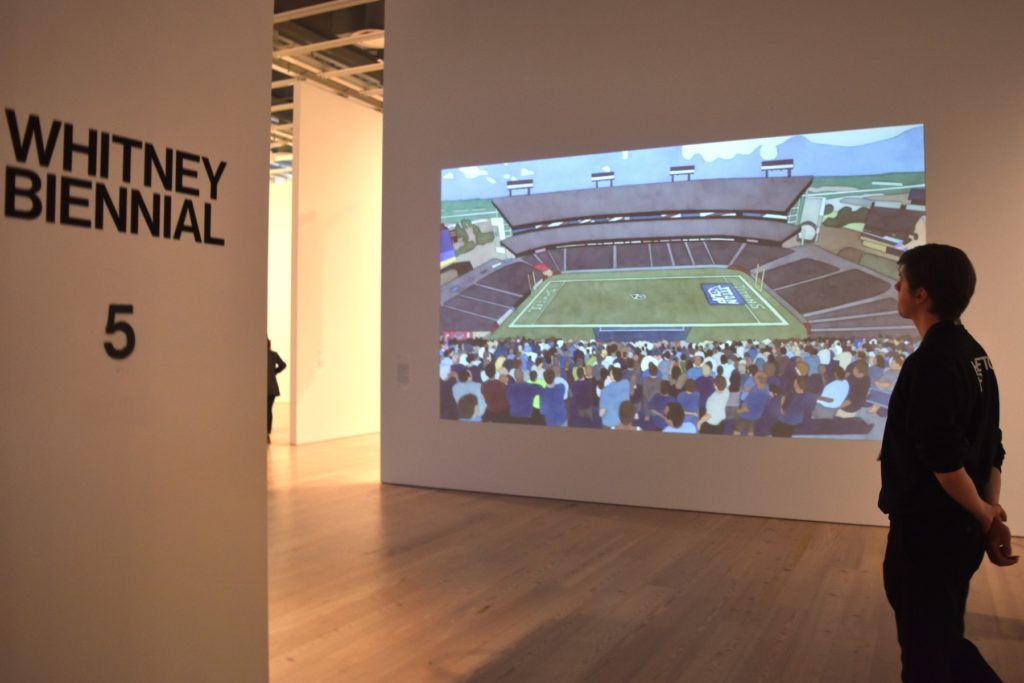
Installation view of Kota Ezawa, National Anthem (2018). Image courtesy Ben Davis.
There are works that point directly to the political situation looming over questions of representation in the present. For instance, Kota Ezawa’s animation depicts the NFL protests—ongoing since 2016—that have seen football players kneeling during the National Anthem to call attention to police and vigilante killings of black citizens.
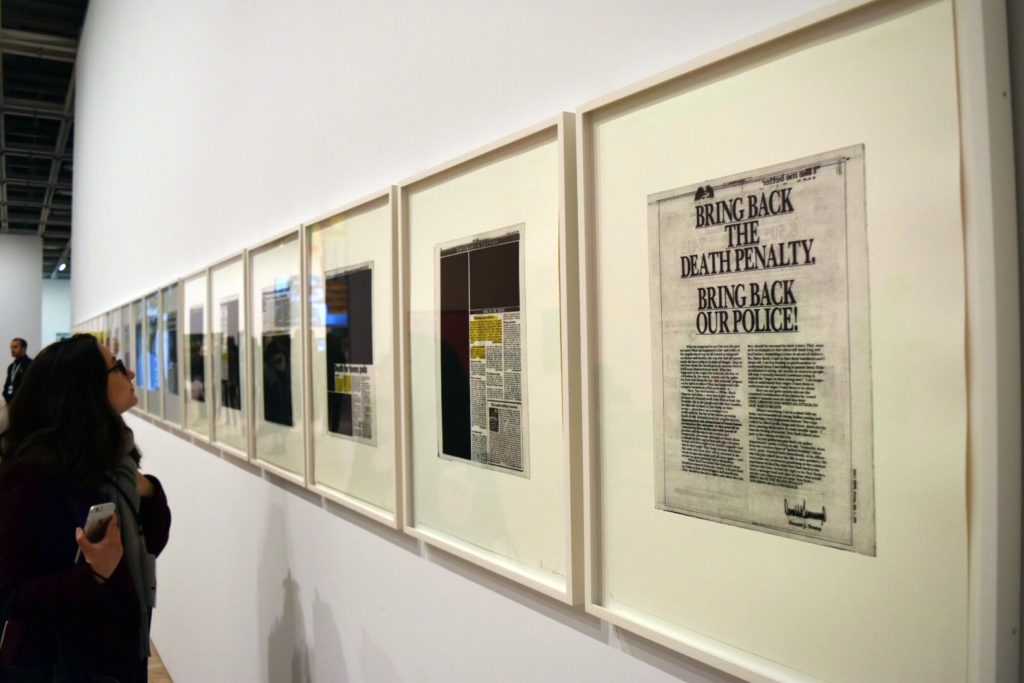
Works from Alexandra Bell’s “No Humans Allowed: After Sylvia Wynter” series (2019). Image courtesy Ben Davis.
Alexandra Bell displays copies of articles from the New York Daily News, with righteous redactions, showing the racially charged media frenzy around the 1989 Central Park Five case—now an infamous example of wrongful incarceration—culminating with the full-page ad that Donald Trump personally took out, for $85,000, to demand that the accused young men be given the death penalty.
But in this show, the directness of these works just reminds you exactly how charged public discourse feels now, and why there might otherwise be a reflex to seek the control of a personal language or a private and nourishing mental space.
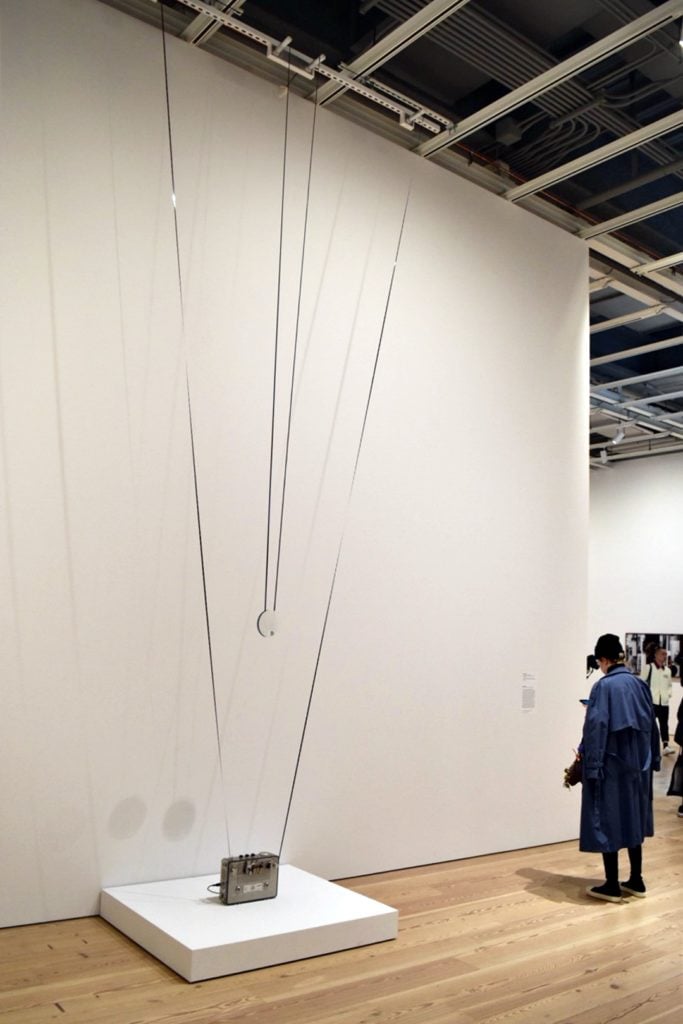
Marcus Fischer, Untitled (Words of Concern) (2017). Image courtesy Ben Davis.
Marcus Fischer’s work, Untitled (Words of Concern), is an appealingly minimal audio piece, made on the day before Trump’s inauguration. Its soundtrack splices together words from fellow residents of an artist colony, speaking their fears. The specifics of what they say will not shock any already liberal viewer (“racism,” “homophobia,” “education,” “Russia,” “guns,” “polar bears,” and so on). The point seems less ringing denunciation than a therapeutic, meditative process of coping.
“Unsurprisingly, the work we encountered was politically and socially minded,” Panetta writes in her own catalogue essay. “But it’s as equally committed to what is possible formally. Perhaps as anger has settled, any initial impulse to make more vitriolic work has felt unproductive.”
The second explanation for this show’s overall tone is more art-specific.
Since the election, there has been a voracious hunger in art for both symbolic images of protest and redemptively affirmative figuration. (This trend reached an apotheosis in the tremendous public interest in Kehinde Wiley and Amy Sherald’s portraits of Barack and Michelle Obama last year.)
But this demand for art with clear markers of identity can be a double-edged sword. Melissa Smith has recently written about how it has already led to burnout and cynicism among some emerging black artists, who see “blackness” as being consumed as a trend. So in part the turn to illegibility might be a reaction to the new visibility, scrutiny, and attention placed on identity that the 2019 Biennial itself represents.
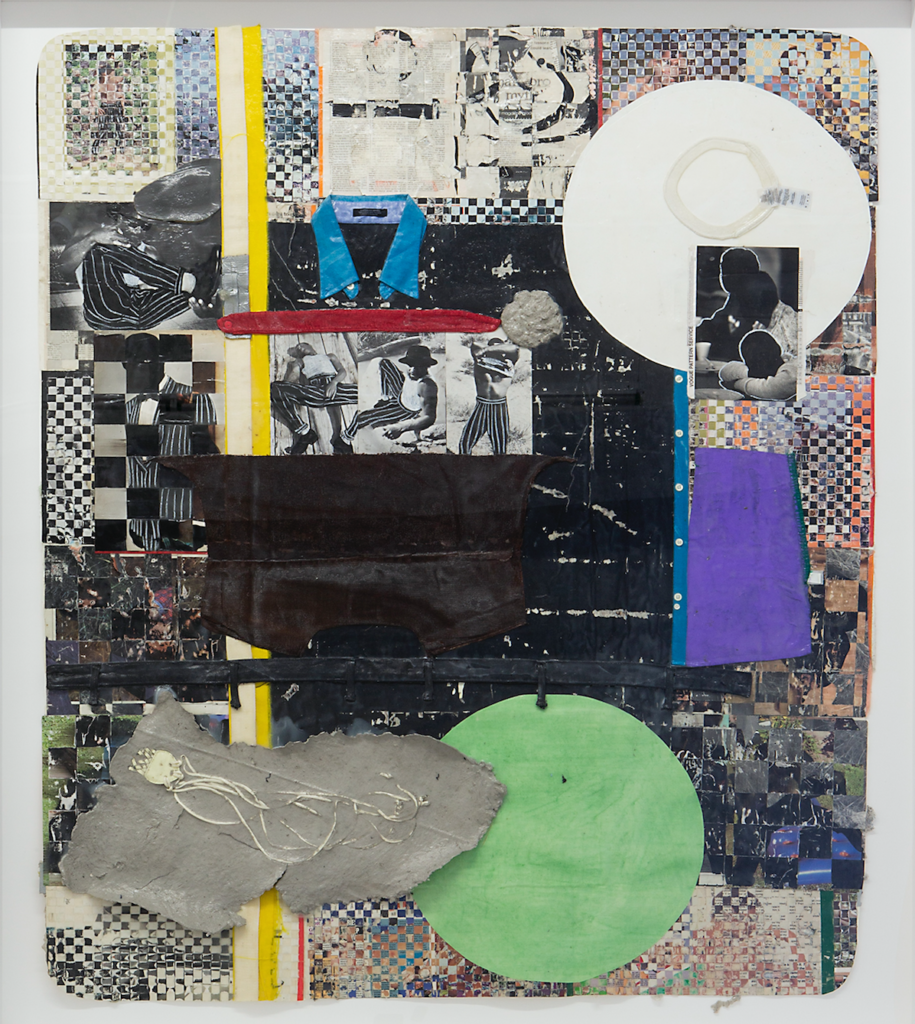
Troy Michie, Los Atravesados/The Skin Of The Earth Is Seamless (2019). Image courtesy Whitney Museum of American Art.
Take Troy Michie’s paintings, very much in the regnant muddied-collage style. They feature scraps of colorful clothing and backgrounds woven from vintage gay porn magazines fetishizing men of color, rendering them illegible. The fabric patches refer to the zoot suit, a flamboyant style of clothing innovated by African Americans in the ’30s and ’40s; in a 1943 outbreak of racist violence, white Angelinos targeted anyone sporting the look—mainly Mexican American youth—in what became known as the Zoot Suit Riots.
The material that Michie conjures together in the composition, therefore, amounts to a kind of coded statement about the price of visibility, in terms of both being exposed and being exoticized—and the codedness itself seems part of the strategy to cope with it.
The truth is that this ebb and flow of demands for visibility and then questioning of over-visibility is a recurring pattern in art history. This is one of the points I take away from art historian Darby English’s How to See a Work of Art in Total Darkness, a book about the pitfalls of the category of “black art”: “[W]here the struggle for recognition is concerned, in some measure the terms of victory may themselves have precipitated a new struggle of an altogether different kind: to trip up or thwart recognition, to open negotiation that draws looking beyond the surface.”
As for the third way to read the biennial, the curators note that the other zeitgeist they are picking up on is the turn to the handmade, read as a possible rejection of the digital. I wonder how much this retreat from the digital is actually connected to the defensively hermetic quality.
Online spaces have both accelerated the visibility of demands for recognition of all kinds, and led to an intensified penetration of unwanted vitriol and scrutiny into all aspects of life, as well as creating a constant intimacy with bad news and traumatic imagery. The verdict is pretty much in that constant exposure to social media increases depression and anxiety.
The early reviews of the 2019 Biennial have tagged this show as playing it safe, but I wonder if it is not, in fact, more about safety—including safety from the relentless online scrum, the kinds of scarring debates that marked the last Whitney Biennial. You can almost feel the anxiety as you peruse the show texts, as if the curators are preemptively trying to frame every artist as maximally personally righteous, and to take account of any possible negative associations, in an environment where any signifier that gets pinned down too clearly to a negative meaning can take on a life of its own.
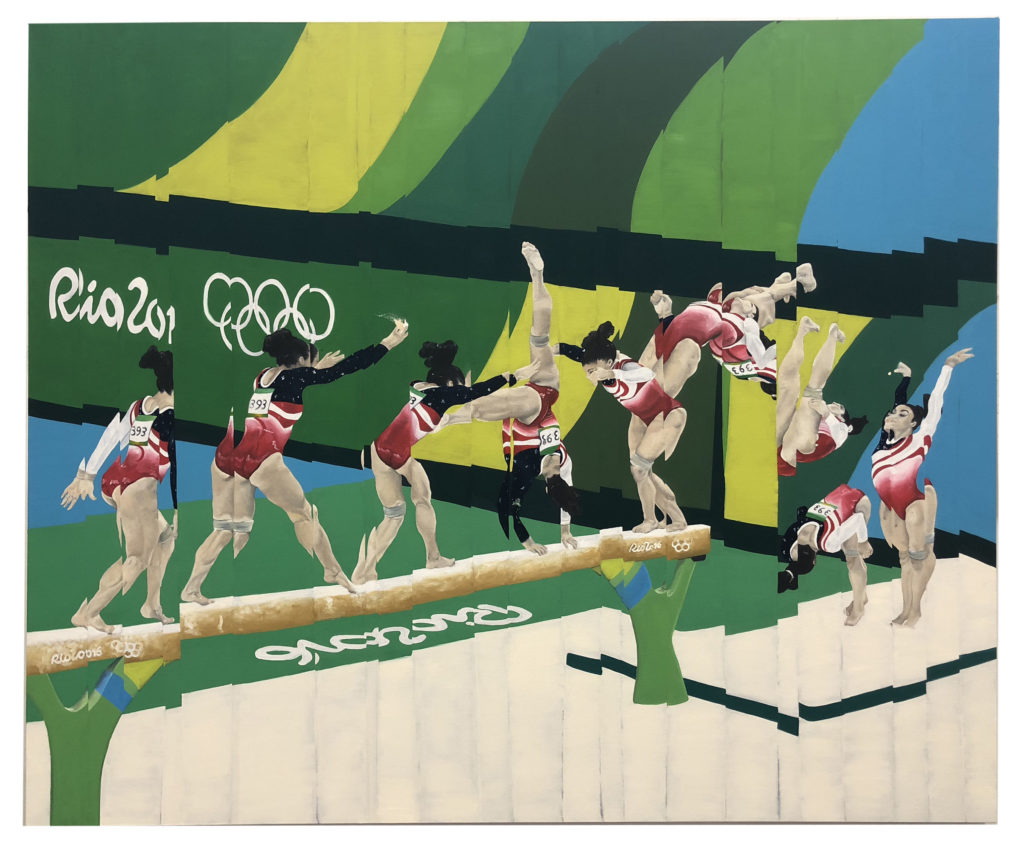
Jeanette Mundt, Born Athlete American: Laurie Hernandez I (2018). Image courtesy Whitney Museum of American Art.
But the undesired associations keep slipping in. Jeanette Mundt offers striking, fractured paintings depicting US gymnasts in action, performing their Olympic routines. The gallery text concludes, “Not long after Mundt began this series, which she continues to work on, news broke that the USA Gymnastics national team doctor sexually abused many young gymnasts including the women who appear here.”
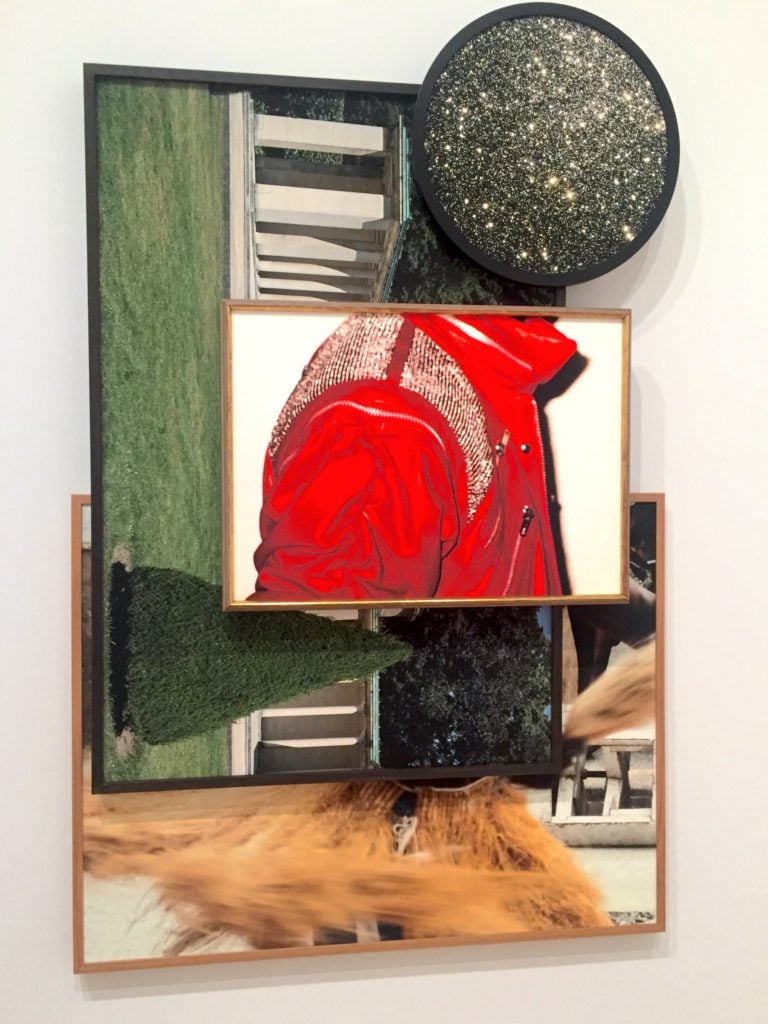
Todd Gray, Euclidian Gris Gris 2 (2018). Image courtesy Ben Davis.
Todd Gray’s fascinating sculpture-photo-painting hybrids mine his own personal archive as a photographer, permuting images into disorienting Exquisite Corpse-style images. Among the works, Michael Jackson recurs; Gray happens to have been the pop star’s personal photographer in the 1970s and ‘80s. But here, he explains, he is using Jackson as a symbol of something larger: of global celebrity and “the African body, the Black body.”
The wall text lays out his intentions—but then also offers the following separate disclaimer: “Michael Jackson was accused of child sexual abuse in 1993 and then tried and acquitted for the crime in 2005. New allegations surfaced in a documentary released on HBO earlier in 2019.”
The ability of artist or museum to corral symbolic associations has broken down in the present information environment. And you can imagine how this, too, might lead to an increased emphasis on carving out personal space, both physically and symbolically.
This year, the controversies that have perennially dogged the Whitney Biennial began before the show was even up, in the form of the weeks of organizing and protest over the presence of tear-gas mogul Warren Kanders on the Whitney’s board, climaxing (for now) with a march on Friday.
As with the molestation charges that have suddenly led to boycotts of Michael Jackson, the information about Kanders’s activity as the boss of weapons company Safariland was not exactly new—it just took on a new virulent life in an explosively charged news climate.
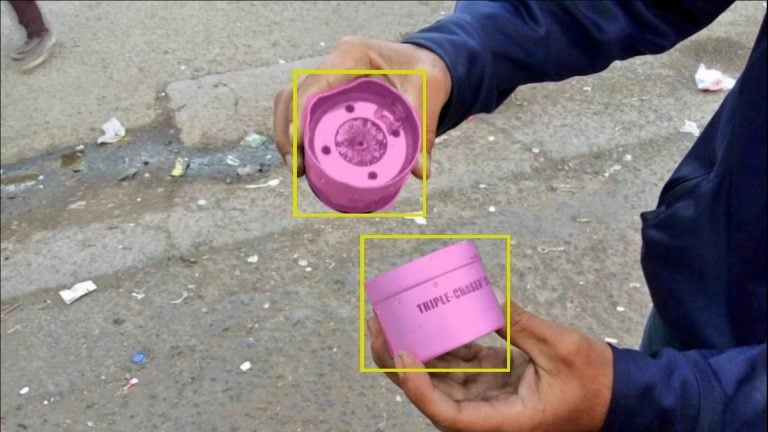
Still from Forensic Architecture, Triple-Chaser (2019). Image courtesy Forensic Architecture/Praxis Films.
The collective Forensic Architecture has turned its biennial commission around to address the subject of Kanders and his business interests directly. Narrated by David Byrne and edited with the help of Laura Poitras, Triple-Chaser documents the group’s attempt to create a computer-vision application to hunt the internet for evidence of nefarious uses of Safariland products, all in an effort to help human-rights researchers.
It will be open to the charge of somehow being an example of the Whitney trying to mitigate protest by channeling it into harmlessly self-inoculating institutional critique (even though its content seems to have been arrived at independently of the museum or curators who invited the group).
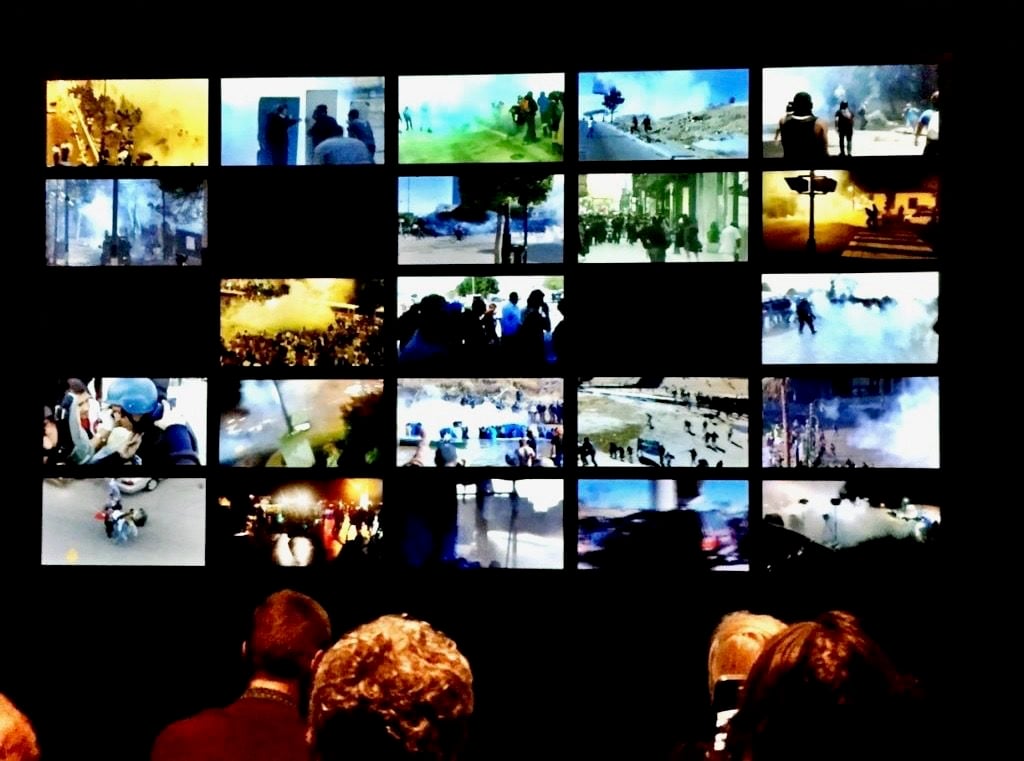
Forensic Architecture’s video project Triple-Chaser at the Whitney Biennial. Photo by Eileen Kinsella
Personally, I think it eludes this trap by connecting up to processes of research and organizing outside of the institution. The video documents how independent human-rights monitors have already put Forensic Architecture’s research to work, advocating for war-crimes investigations into Kanders’s companies linked to bullets used in the Israeli-occupied Palestinian territories. I think it’s a sharp work.
It serves multiple functions at once. It is a prosecutorial gathering of evidence, and also an artistic reflection on the forms of internet-era activism. And, in the contradiction it presents—bringing the spectacle of protest against the Whitney’s business ties inside the Whitney’s signature event—it also underscores just how loaded with difficulties the whole enterprise of public space and public representation is right now—which seems to be the situation that much of the work in this show is navigating, in its different ways.